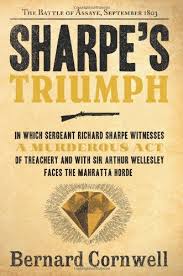 Bernard Cornwell, Sharpe’s Triumph: Richard Sharpe and the Battle of Assaye, September 1803 (New York: HarperCollins, 1998). Hardcover | Paperback | Kindle
Bernard Cornwell, Sharpe’s Triumph: Richard Sharpe and the Battle of Assaye, September 1803 (New York: HarperCollins, 1998). Hardcover | Paperback | Kindle
Midway through reading Sharpe’s Tiger, the first volume (chronologically) in Bernard Cornwell’s Richard Sharpe series, I hurriedly ordered the second volume for two-day delivery from Amazon. I am a series reader, and this clearly is a series to be read. It follows the exploits of Richard Sharpe, a soldier in the British Army, during the era of the Napoleonic Wars.
Sharpe’s Tiger was set in India in 1799 and focused on the siege of Seringapatam in the spring of 1799. Sharpe’s Triumph picks up the story four years later as the British Army under Gen. Arthur Wellesley—after Waterloo, the Duke of Wellington—fights against the numerically superior Mahratta Horde at Ahmednuggur and then Assaye. (I’m using Cornwell’s terms and spellings. Wikipedia prefers Maratha, Maratha Empire or Maratha Confederacy, and Ahmednagar, in case you want to look them up.)
Cornwell doesn’t paper over the greedy motives and savage conduct of the British or other Europeans as they fought for control of the Indian subcontinent. He doesn’t valorize their enemies either, however. What he does is present the conflict from a British soldier’s point of view, showing his courage under fire.
And what courage it was! Cornwell’s description of the British escalade at Ahmednuggur, in which Lt. Colin Campbell of the Scottish 78th Regiment mounted a ladder three times to scale the fortress wall—a true story, by the way—astonishes the reader as much as it astonished Campbell’s contemporaries. (Campbell received a battlefield promotion to colonel, and in later years he was knighted and served as governor of Ceylon, now Sri Lanka.)
But Cornwell’s description of the British assault at Assaye, in which the 78th calmly marched in formation under enemy fire, took a beating, but still went on to crush the Mahratta right flank, is even more astounding. Sometime after his victory at Waterloo, the Duke of Wellington was asked which was his finest battle. He answered: “Assaye.” When you read this book—which is, remember, a work of historical fiction—you’ll nonetheless understand why.
_____
P.S. If you found my review helpful, please vote “Yes” on my Amazon.com review page.

